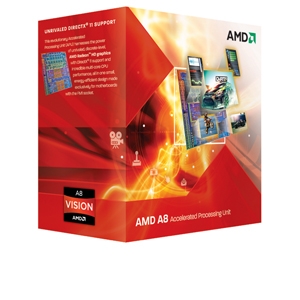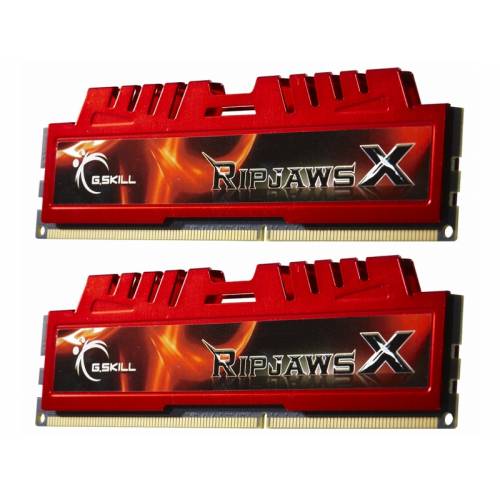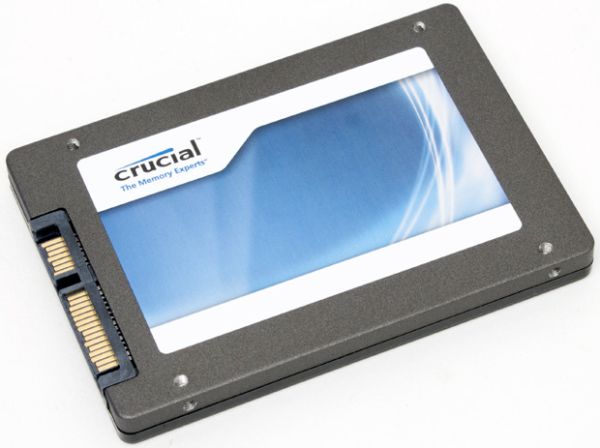Holiday 2011 Midrange System Buyer's Guide
by Zach Throckmorton on December 6, 2011 12:00 AM EST- Posted in
- Guides
- AMD
- Intel
- Sandy Bridge
- Llano
- Holiday 2011
- midrange
- NVIDIA
The AMD A8-3850 APU
Since its retail availability in July, AMD's Llano series of APUs (accelerated processing units) has offered vastly improved integrated graphics performance compared to previous chips from both AMD and Intel. The on-die graphics capability of the Llano chips is good enough to play even more demanding titles like Crysis acceptably, at least on medium resolutions and settings. The computing experience is also more than sufficient for generalized, day-to-day desktop computing.

Anand previewed and then fully reviewed the A8-3850 upon its release. You can get a great idea of what to expect, performance-wise, from his articles. The platform has matured since its launch, and prices on the supporting motherboards have fallen a bit over the last few months, making Llano an increasingly attractive choice for lower midrange gamers. As Anand's testing indicates, the A8-3850 is roughly equivalent to the Intel Core i3-2100—in general, the Intel chip takes the lead in single-threaded workloads while the AMD APU wins in multi-threaded scenarios. In order to get the Intel system up to par with the AMD rig in terms of graphics performance, you have to spend at least another $50 on a budget discrete GPU. For more casual gamers, that extra cost simply isn't necessary.
The parts
We've paired the A8-3850 with the fully-featured ASUS F1A75-M PRO/CSM motherboard. This is a well-designed board that features four rear USB 3.0 ports and two USB 2.0 ports, with headers for two more USB 3.0 ports and eight additional USB 2.0 ports. Other ports and interfaces include D-Sub, DVI, and HDMI video outs, an optical port, and GbE ethernet (among many other less important interfaces).
The build also features a Crucial M4 64GB SSD. AnandTech has long stressed how adding an SSD to a modern computer makes for a much improved, faster, and snappier all-around computing experience. Anand reviewed the M4 earlier this year. Since then, it has earned a reputation as a solid (though not stellar) performer, that is perhaps more importantly also very reliable. It has also become quite affordable. Though 64GB is plenty of space for the OS and many applications, it's insufficient for a large game and/or media library. Thus we've paired the speedy SSD with the venerable Samsung F3 1TB HDD. That said, because the anomalously high prices of mechanical hard drives puts this storage combination's total price at over $250, it's also worth considering ditching the mechanical drive altogether and going with only a higher capacity SSD like Intel's 320 Series 160GB SSD--you can always add a hard drive down the road when the prices come back down.

For the memory, we have an 8GB (2 x 4GB) kit of DDR3-1866. Anand's review of the A8-3850 showed that Llano benefits from higher bandwidth RAM, though this difference is not always that remarkable. You can save a few dollars by instead opting to go with a slower kit like this standard Kingston DDR3 1333 pair.
Rounding out the build, we once again turn to Antec's stalwart NEO ECO 400C power supply. I've put this PSU in many builds now and have yet to experience an issue with one. It is quiet, efficient, its cables are sleeved, 400W is more than enough power for any mainstream single GPU (or in this case, GPU-less) system, and it is not expensive at all.
All of the parts are housed in a Fractal Design Arc Midi, which Dustin reviewed recently. I really like this case and the customers for whom I've built systems with it rave about the Arc Midi. It has an integrated, ready-to-go (i.e. no aftermarket parts necessary) front USB 3.0 port, excellent thermals and acoustics, and while looks are subjective, I think it's very stylish.
| Component | Product | Price |
| Processor | AMD A8-3850 APU | $140 |
| Motherboard | ASUS F1A75-M PRO/CSM | $110 |
| RAM | G.SKILL Ripjaws X Series 8GB DDR3 1866 | $60 |
| SSD | Crucial M4 64GB | $110 |
| HDD | Samsung Spinpoint F3 1TB | $150 |
| Power supply | Antec NEO ECO 400C 400W | $35 |
| Case | Fractal Design Arc Midi | $100 |
| Optical drive | LITE-ON iHAS324-98B | $20 |
| Operating system | Windows 7 Home Premium 64-bit (OEM) | $100 |
| Total: | $805 |
Summary
This is a well-rounded system that is capable of casual to moderate gaming without the extra cost (and electricity) of a discrete video card. The quad-core A8-3850 and 8GB DDR3 facilitate great multitasking while maintaining good single-threaded performance. In addition to the reviews linked above, you can get a better picture of this APU's performance on AnandTech's Bench. The motherboard has room for a discrete GPU should you want to upgrade eventually, and has all of today's bells and whistles in terms of connectivity. The combination of the SSD and HDD offers the best of both worlds: SSD speed and HDD capacity. Finally, the case and PSU offer plenty of upgradeability for more storage (when HDD prices inevitably settle down in a few months) and thermals that will easily accomodate additional heat-generating internal components like a discrete GPU.
If you're looking for more computational and graphics power, check the next page for our $1000 Intel-based system.











57 Comments
View All Comments
aznofazns - Tuesday, December 6, 2011 - link
"I don't consider this an "ass-whoopin". That would be considerably faster (50% or more) on all benchmarks. The i3 isn't even close to that."You're entitled to your definition of the term, but I consider anywhere from 25-50% better IPC an ass-whoopin. Take a look at Cinebench, Mediaespresso, and Photoshop benchmarks results (not just on Anandtech, but other reviews too).
In the multi-threaded situations in which the A8 takes the lead, it only wins by 10-15%. If you primarily use your PC for these types of workloads, the A8 may be worthwhile. But I'm going to go out on a limb here and assume the majority of users this build is designed for will gladly trade 10-15% multi-threaded performance for 25-50% higher IPC.
"One place where the i3 clearly shines over the A8 is gaming performance (assuming that both systems are using dedicated cards, which really isn't fair to the A8 since its integrated graphics are so good), but seriously, who even cares about gaming performance of PCs anymore?"
Tell that to all the hardcore PC gamers out there. With recent titles like BF3 and Skyrim, PC gaming is still very relevant. If you're not breaking that magical 60fps barrier in most games, you will notice. Also, with 120Hz monitors becoming more prevalent, don't you think gamers would find it worthwhile to invest in a faster CPU?
"It depends on workload and for most casual users, the differences would never be noticed anyway."
This is completely true, but what percentage of casual users would be spec-ing out and building a custom desktop like this in the first place? The argument that "you wouldn't notice anyway" doesn't justify spending the same amount of money on a CPU that performs worse in most situations.
bji - Wednesday, December 7, 2011 - link
Your points are all good and well taken. I personally happily trade per-core IPC for greater multithreaded efficiency because I have no single-threaded tasks that I need better performance on, but do have multithreaded tasks (parallel compiles of large software) that benefit immensely from multi core. But not everyone has the same needs as me, which was kind of my point; you can't say that one chip is objectively better than the other, it depends on your workload.I think that perhaps the real problem here is that there is some inconsistency between the concept of a build-it-yourself low-end system and the target audience.
Only enthusiasts are qualified to take the advice of a build-it-yourself article, and enthusiasts almost always will have requirements that take them out of the low-end system market.
And those enthusiasts who actually do need a low-end system probably have a better idea of the specific requirements that would guide their decisions on topics such as CPU choice better than the article writer ever could, so trying to create a one-size-fits-all CPU choice for the enthusiast is an exercise in futility.
aznofazns - Wednesday, December 7, 2011 - link
You definitely have a point here. Enthusiasts probably would not build a low-end machine like this to serve as their primary PC. And a "one-size-fits-all CPU" is definitely an exercise in futility, as you mentioned.I still like to think that *most* enthusiasts looking to build a budget rig like this (for basic gaming, HTPC, whatever) will be more satisfied with the i3 Sandy Bridge + HD6670 configuration.
It's always down to the individual user, but I think the Llano A8 chip would serve a better purpose in a slightly different type of system, like a low-profile mini-ITX HTPC.
Regardless, I think your arguments are valid, and your comment on the target audience is one that didn't really cross my mind.
xgrifter - Wednesday, December 7, 2011 - link
The A8 beats the i3 in gaming should just look at the article at pc perspective http://www.pcper.com/news/Graphics-Cards/Video-Per...aznofazns - Thursday, December 8, 2011 - link
That's looking at the integrated graphics performance of both chips. Pair each one with a mid to high end GPU and the picture changes completely.DanNeely - Tuesday, December 6, 2011 - link
For a lower level system mAtx makes a lot of sense; except that it should've been bundled with an mAtx case as well if not at a half width SFF one. It's target audience is unlikely to ever use an expansion card at all, except perhaps if they decide to go with internal wifi so they don't have to worry about the USB dongle falling off. Less space on the desk OTOH is always a bonus.FATCamaro - Tuesday, December 6, 2011 - link
I like your opinions & alternatives. You should write some articles yourself.medi01 - Tuesday, December 6, 2011 - link
It's funny to read about "superior gaming systems" without discrete graphic card.For this review to be honest, it had to include A3850 + discrete graphic card configuration. (which would still be cheaper than Intel config).
AMD motherboard costing more than Intel's look strange, to say the least.
Z Throckmorton - Tuesday, December 6, 2011 - link
Hi Mathieu - Thank you very much for your thorough, informative, and polite post! I very much appreciate it.I recognize that an i3-2100+6670 combination is in many ways superior to the A8-3850 I outlined in the guide. However, having assembled many of both systems, for the average user, it really is, in my opinion, a wash. Especially if you're not using a 1080P monitor, as I mentioned in the text of the guide. In my experience the i3 is better under lighter usage scenarios but the A8 wins in more involved multitasking scenarios. This isn't something that can be illustrated with benchmarks, it's really something you have to experience in person performing a familiar workflow. That, and the fact that the A8 idles and loads at a lower power draw are the primary reasons I gave it the nod in the guide. While the upgradeability of an i5 or i7 is definitely a bonus for an i3 rig, the primary intent of this article was to outline systems that will last for five years as they are described. And while enthusiasts have no trouble swapping CPUs and such, adding components as I mentioned in the other builds is always easier than swapping parts.
I do disagree with your assertion that a PCIe x4 slot will bottleneck a 6850. Poke around online and there are numerous articles illustrating that it will not.
Your point about mentioning where additional cables are necessary is appreciated - I've forgotten that in a previous guide - hopefully it won't take more than twice for me to learn my lesson.
Thanks again for your comments!
fmofmofmo - Tuesday, December 6, 2011 - link
But according to this site, Liano is more then 39x faster then core i3-2100http://sharikou.blogspot.com/2011/07/just-realized...
I'm bit sarcastic to post this link because the site is so amd-biased that it's funny.
AMD FX 8150 clearly beats Sandy Bridge i7-2700K
http://sharikou.blogspot.com/2011/11/amd-fx-8150-c...
AMD FX does frag Sandy Bridge after all
http://sharikou.blogspot.com/2011/10/amd-fx-does-f...